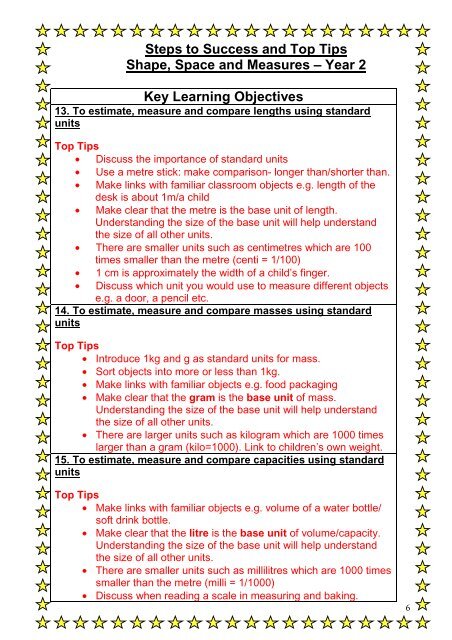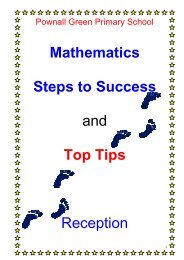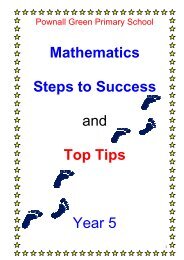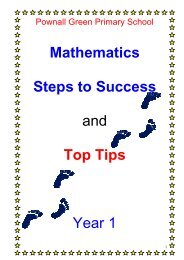Mathematics Steps to Success and Top Tips Year 2 - Pownall Green ...
Mathematics Steps to Success and Top Tips Year 2 - Pownall Green ...
Mathematics Steps to Success and Top Tips Year 2 - Pownall Green ...
Create successful ePaper yourself
Turn your PDF publications into a flip-book with our unique Google optimized e-Paper software.
<strong>Steps</strong> <strong>to</strong> <strong>Success</strong> <strong>and</strong> <strong>Top</strong> <strong>Tips</strong><br />
Shape, Space <strong>and</strong> Measures – <strong>Year</strong> 2<br />
Key Learning Objectives<br />
13. To estimate, measure <strong>and</strong> compare lengths using st<strong>and</strong>ard<br />
units<br />
<strong>Top</strong> <strong>Tips</strong><br />
• Discuss the importance of st<strong>and</strong>ard units<br />
• Use a metre stick: make comparison- longer than/shorter than.<br />
• Make links with familiar classroom objects e.g. length of the<br />
desk is about 1m/a child<br />
• Make clear that the metre is the base unit of length.<br />
Underst<strong>and</strong>ing the size of the base unit will help underst<strong>and</strong><br />
the size of all other units.<br />
• There are smaller units such as centimetres which are 100<br />
times smaller than the metre (centi = 1/100)<br />
• 1 cm is approximately the width of a child’s finger.<br />
• Discuss which unit you would use <strong>to</strong> measure different objects<br />
e.g. a door, a pencil etc.<br />
14. To estimate, measure <strong>and</strong> compare masses using st<strong>and</strong>ard<br />
units<br />
<strong>Top</strong> <strong>Tips</strong><br />
• Introduce 1kg <strong>and</strong> g as st<strong>and</strong>ard units for mass.<br />
• Sort objects in<strong>to</strong> more or less than 1kg.<br />
• Make links with familiar objects e.g. food packaging<br />
• Make clear that the gram is the base unit of mass.<br />
Underst<strong>and</strong>ing the size of the base unit will help underst<strong>and</strong><br />
the size of all other units.<br />
• There are larger units such as kilogram which are 1000 times<br />
larger than a gram (kilo=1000). Link <strong>to</strong> children’s own weight.<br />
15. To estimate, measure <strong>and</strong> compare capacities using st<strong>and</strong>ard<br />
units<br />
<strong>Top</strong> <strong>Tips</strong><br />
• Make links with familiar objects e.g. volume of a water bottle/<br />
soft drink bottle.<br />
• Make clear that the litre is the base unit of volume/capacity.<br />
Underst<strong>and</strong>ing the size of the base unit will help underst<strong>and</strong><br />
the size of all other units.<br />
• There are smaller units such as millilitres which are 1000 times<br />
smaller than the metre (milli = 1/1000)<br />
• Discuss when reading a scale in measuring <strong>and</strong> baking.<br />
6







